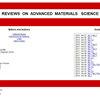在保持电阻率的同时,通过搅拌摩擦工艺提高纯铜和 Cu-TiO2 复合材料的硬度和耐磨强度
IF 3.6
4区 材料科学
Q2 MATERIALS SCIENCE, MULTIDISCIPLINARY
引用次数: 0
摘要
本研究旨在通过摩擦搅拌加工(FSP)提高铜和铜-二氧化钛基复合材料的硬度和耐磨性,同时保持高导电性。研究评估了 TiO2 体积分数和沟槽宽度 (GW) 对 FSP 化铜和 FSP 化铜-TiO2 表面复合材料的磨损、硬度、电阻率和微观结构的影响。从搅拌区获得的样品显示,由于颗粒细化、分布均匀以及 TiO2 与 Cu 的有效粘附,Cu-TiO2 表面复合材料的显微硬度有所提高。此外,磨损率随着复合材料中 TiO2 体积分数的降低而增加。磨损表面的微观结构分析表明,随着 TiO2 体积分数和 GW 的增加,磨损从剧烈过渡到温和。与纯铜相比,强化搅拌区的平均晶粒尺寸明显减小,随着沟槽尺寸的增大,晶粒尺寸进一步减小。与未加工的铜相比,硬度分别增加了 25% 和 50%,但在 FSP 之后,电阻率仅有微不足道的增加(2.3% Ωm)。本文章由计算机程序翻译,如有差异,请以英文原文为准。
Enhancement of hardness and wear strength of pure Cu and Cu–TiO2 composites via a friction stir process while maintaining electrical resistivity
The study aims to enhance the hardness and wear of copper and Cu–TiO2 -based composites while maintaining high electrical conductivity through friction stir processing (FSP). It assesses the impact of TiO2 volume fractions and groove widths (GWs) on the wear, hardness, resistivity, and microstructure of FSPed Cu and FSPed Cu–TiO2 surface composite. The samples obtained from the stir zone showed an increase in microhardness of the Cu–TiO2 surface composite due to particle refinement, uniform distribution, and efficient sticking of TiO2 with Cu. Furthermore, the wear rate increased with decreasing TiO2 volume fractions in the composite. The worn surface microstructural analysis indicated a transition from harsh to gentle wear with increasing TiO2 volume fractions and GWs. The average grain size reduced significantly in reinforced stir zones compared to pure Cu, and particle size decreased further with increasing groove size. Hardness increased by 25 and 50% compared to unprocessed Cu, but only a negligible increase in electrical resistivity (2.3% Ωm) after FSP.
求助全文
通过发布文献求助,成功后即可免费获取论文全文。
去求助
来源期刊

Reviews on Advanced Materials Science
工程技术-材料科学:综合
CiteScore
5.10
自引率
11.10%
发文量
43
审稿时长
3.5 months
期刊介绍:
Reviews on Advanced Materials Science is a fully peer-reviewed, open access, electronic journal that publishes significant, original and relevant works in the area of theoretical and experimental studies of advanced materials. The journal provides the readers with free, instant, and permanent access to all content worldwide; and the authors with extensive promotion of published articles, long-time preservation, language-correction services, no space constraints and immediate publication.
Reviews on Advanced Materials Science is listed inter alia by Clarivate Analytics (formerly Thomson Reuters) - Current Contents/Physical, Chemical, and Earth Sciences (CC/PC&ES), JCR and SCIE. Our standard policy requires each paper to be reviewed by at least two Referees and the peer-review process is single-blind.
 求助内容:
求助内容: 应助结果提醒方式:
应助结果提醒方式:


